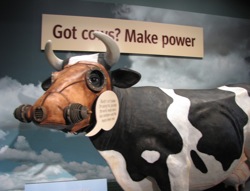Science museums, aquariums and other “informal educators” walk a tightrope when it comes to climate change.
By Marjorie Sun
The California Academy of Sciences and the Monterey Bay Aquarium have a big advantage that some educational institutions in other parts of the country don’t: most of their visitors — who tend to be Californians — believe that climate change is real. That means their global warming exhibits can focus on solutions, for example, rather than laying out the basics of atmospheric science.
Californians’ concern about climate change has translated into political support for cutting greenhouse gas emissions. According to survey results released in July by the Public Policy Institute of California, two-thirds of Californians strongly back the pioneering state law known as AB 32. The law requires a reduction of greenhouse gas emissions to 1990 levels by 2020. And the recent defeat of Proposition 23 by 22 percentage points would appear to affirm that support.
Californians appear to buck some national trends on climate change issues. A declining number of Americans say there is solid evidence that the world is warming. The number dropped from 79% in 2006, when AB 32 was passed, to 59% this year, according to a survey just released by the Pew Research Center. The number who think scientists agree that the world is warming due to human activity fell from 59% to 44% over the same period. Even more telling, perhaps, is that the ratio of “yes” to “no” answers to the latter question for Republicans (30:58) is almost the mirror image of that for Democrats (59:32).
New Yorker journalist Jane Mayer details in a recent, in-depth article that billionaires David and Charles Koch, titans of the oil industry, have been spending millions of dollars waging a covert disinformation campaign to thwart climate change legislation in the United States.
Aboard the Bio-Bus
A local organization has launched a mobile counter-offensive. The Alliance for Climate Education, a non-profit based in Oakland, has created a hip, multi-media presentation spiced with animation and rock music to reach teens. Think An Inconvenient Truth goes MTV. The alliance has shown it to more than 420,000 high schoolers across the nation in the past year. The presentation teaches teens the basics about climate change and urges them to “do one thing” to fight it.
Alliance staffers also have tricked out an old school bus with clean tech, driving it to schools and museums to showcase renewable technology. The blue bio-bus runs on used cooking oil collected from restaurants. Solar panels on the bus charge cell phones and computers on board.
Unmasking the Cow

Meanwhile, keeping the climate change exhibits up-to-date scientifically is a concern for the museums. At the Monterey Bay Aquarium, outfitting a life-size model cow with a gas mask was prompted in part by a 2006 study by the Food and Agriculture Organization. The FAO study said that industrial production of livestock in general, including cattle, pigs, and poultry, accounts for 18% of all greenhouse gas emissions. But another FAO study released in April — about the same time the climate change exhibit opened — examined the GHG emissions for the dairy industry alone, not beef production. It concluded that dairy production contributes just four percent of emissions. The study (PDF download), along with howls of protests from the local dairy industry, helped convince the aquarium to unmask the Holstein.
One last tidbit about interactive exhibits: One of the most popular — common to the Academy and the Monterey Bay Aquarium — is surprisingly low-tech. Thousands of visitors write on comment cards about what they can do to fight climate change and hang them on display boards there. One of them, in a child’s handwriting, read “Reduce, reuse, recycle and homework is bad for the environment.”
Hear Marjorie’s companion radio feature on KQED’s Quest radio program, Monday morning. A version of this post also appears on the Quest blog.
2 thoughts on “Taking Climate Education to the Streets”
Comments are closed.

In it’s dying days, Climate Change has been reduced to “all the experts say” and those evil republicans. Gee, religion?
Meanwhile, the UN had allowed carbon trading to trump 3rd world fresh water relief, starvation rescue and 3rd world education for just over 24 years of climate control instead of population control.
“The blue bio-bus runs on used cooking oil collected from restaurants. “
That cracks me up. If you ever worked at a restaurant you’d be laughing too.
Used cooking oil – must mean it’s free – lol.
Oh there has to be enough of it to run a fleet of school buses – right?
Morons.